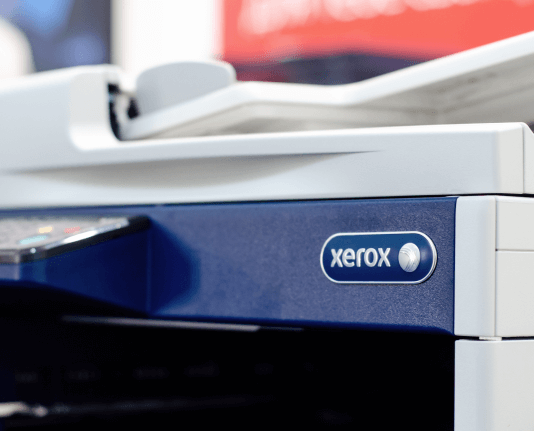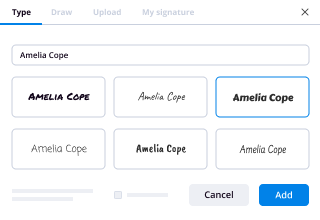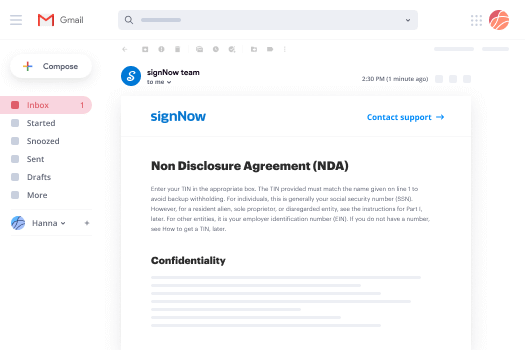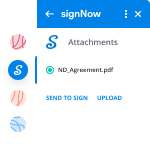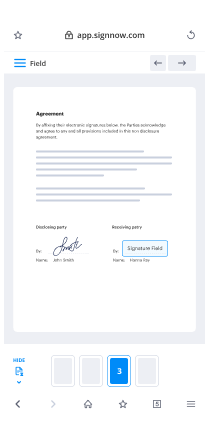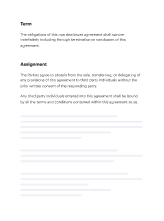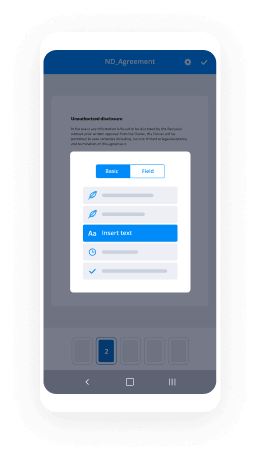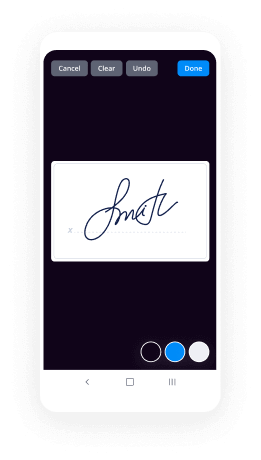Electronic signature Form for IT Later
Make the most out of your eSignature workflows with airSlate SignNow
Extensive suite of eSignature tools
Robust integration and API capabilities
Advanced security and compliance
Various collaboration tools
Enjoyable and stress-free signing experience
Extensive support
Keep your eSignature workflows on track
Our user reviews speak for themselves






Advantages of utilizing an electronic signature form
In the current digital era, employing an electronic signature form is vital for optimizing document handling and boosting business productivity. airSlate SignNow provides an intuitive platform that enables organizations to send, sign, and oversee documents effortlessly. This guide will lead you through the straightforward steps to utilize airSlate SignNow for your electronic signature requirements.
Step-by-step guide for utilizing an electronic signature form with airSlate SignNow
- Launch your web browser and go to the airSlate SignNow homepage.
- Set up a free trial account or log into your current account.
- Choose the document you want to sign or send for signatures and upload it.
- If you intend to use this document regularly, convert it into a reusable template.
- Open your uploaded file and tailor it by adding fillable fields or inserting necessary details.
- Include your signature and specify signature fields for other signers.
- Click 'Continue' to complete and send the invitation for e-signature.
By adhering to these uncomplicated steps, you can efficiently manage your documents and signatures with airSlate SignNow. Its extensive features and user-friendly interface make it a signNow asset for any organization.
Don't pass up the chance to improve your document management workflow. Begin your free trial today and discover the advantages of airSlate SignNow firsthand!
How it works
Rate your experience
-
Best ROI. Our customers achieve an average 7x ROI within the first six months.
-
Scales with your use cases. From SMBs to mid-market, airSlate SignNow delivers results for businesses of all sizes.
-
Intuitive UI and API. Sign and send documents from your apps in minutes.
A smarter way to work: —how to industry sign banking integrate
FAQs
-
What is an electronic signature form and how does it work?
An electronic signature form is a digital version of a traditional paper form that allows users to sign documents electronically. This form streamlines the signing process by enabling users to add their signatures using a mouse, touchscreen, or stylus. With airSlate SignNow, you can create, send, and manage these forms easily, ensuring a fast and secure signing experience.
-
How much does it cost to use airSlate SignNow for electronic signature forms?
airSlate SignNow offers competitive pricing plans tailored to meet the needs of businesses of all sizes. You can choose from a variety of subscription options that provide access to features like unlimited electronic signature forms and document templates. For specific pricing details and to find the best plan for your needs, visit our pricing page.
-
What features does airSlate SignNow offer for electronic signature forms?
airSlate SignNow provides a range of features for electronic signature forms, including customizable templates, automated workflows, and real-time tracking of document status. Additionally, users can collect payments directly through the forms and integrate with various third-party applications for enhanced functionality. This makes it a versatile tool for businesses looking to simplify their document signing processes.
-
Is airSlate SignNow compliant with electronic signature laws?
Yes, airSlate SignNow is compliant with major electronic signature laws, including the ESIGN Act and eIDAS regulations in Europe. This ensures that your electronic signature forms are legally binding and recognized in various jurisdictions. Our commitment to compliance helps you confidently manage your documents without legal concerns.
-
Can I integrate airSlate SignNow with other software applications?
Absolutely! airSlate SignNow offers seamless integrations with a variety of software applications, including CRMs, cloud storage services, and productivity tools. This allows you to streamline your workflow by connecting your electronic signature forms with the tools you already use, enhancing efficiency and productivity.
-
What benefits can businesses expect from using electronic signature forms?
Using electronic signature forms can signNowly reduce turnaround times for document signing, leading to faster transaction completion. Additionally, they help cut costs associated with printing and mailing physical documents. With airSlate SignNow, businesses also benefit from improved organization and tracking of documents, ensuring a smoother signing experience.
-
How secure are electronic signature forms created with airSlate SignNow?
Security is a top priority at airSlate SignNow. Our electronic signature forms utilize advanced encryption and authentication methods to protect sensitive data. Each signed document is securely stored and easily accessible, providing peace of mind that your information is safe and compliant with industry standards.
-
Why doesn't Indian government develop an online voting system so that we can cast our votes while living in other states?
Total market capitalization of Bitcoin, the online currency, touched a maximum of about $300 billion (i.e., about ₹ 21.15 lakh crore) in December 2017.[1] Just to put it in correct perspective, India is total GDP is about $2.6 trillion. And, all transactions in Bitcoin are conducted ONLINE.The total market cap of Indian stock market was about $2.3 trillion in the year 2017. And, all the share transactions are conducted online. There are no physical transactions. All shares in India are held in Demat (dematerialized) or digital form. In fact, transfer of all listed shares will be compulsorily required to be in Demat form only with effect from 1 April 2019 and no physical shares would be transferable from that date (previously, this was to come into effect from tomorrow, i.e., from 5 December 2018, but this deadline has just been extended by SEBI).[2]To give an example, right now, the net worth of Mukesh Ambani, the richest person in Asia, is about $47 billion (i.e., about ₹ 3.30 lakh crore). Most of this net worth is in the form of shares. And, all these shares are held by Mukesh Ambani in digital form. He does not have any physical shares. Unlike what many persons may presume, he may not be holding much physical cash or other physical assets. His net worth is mostly in digital form.Even lesser mortals like me, nowadays, conduct most of our transactions online through Internet. For example, in last 10 years, I have not visited my bank for more than 3-4 times in total. All bill payments, all money transfers, etc., are done online.Railway reservations are nowadays done online by IRCTC. Though, IRCTC website has been infamous for its slow speed (nowadays, however, it has improved its performance drastically), yet I have not come across even a single case in which the ticket reserved through IRCTC website was wrongly booked, i.e., it has never happened that a particular seat is booked twice or that you buy a ticket online and then don’t get the seat.Crores of transactions and other activities are routinely authenticated by Aadhaar online. For last several years, all my IT Returns have been filed online. Even the Digital Signature that I acquired a few years back was authenticated online through Aadhaar. I use this Digital Signature for various purposes, such as verifying my IT Returns.These are just a few examples of how most of our activities are shifting to online transactions. Done through Internet.Yet, when it comes to voting, people are not prepared for voting through Internet. It is surprising. You can put all your money online, but you worried about your vote being online.In fact, it is common to see political parties blaming even the Electronic Voting Machines (EVMs) that are in use in India for last many years.There are people who want to go back to the paper ballot. In fact, just last month (23 November 2018), Supreme Court rejected a PIL which wanted that all elections in India should be conducted through paper ballot instead of EVMs.[3]I am fully in favour of voting taking place through Internet. If transactions worth trillions of dollars can be successfully conducted online through the Internet, I see no reason why voting cannot take place online. It is not difficult to design a fool-proof system, with proper auditing, which cannot be manipulated. Nowadays, Blockchain technology is being repeatedly used for further strengthening the security of online systems. If trillions of dollars can be transferred online without mistakes, there is no reason why votes cannot be cast online.In fact, I was perhaps the first person who had suggested way back in 1996, by way of my article [Corporate Democracy] published in the reputed law journal All India Reporter (AIR) [with the citation of AIR 1996 Journal 130], that voting in a company can also be considered by email with proper safeguards to ensure better corporate democracy in the management of companies. Remember, in 1996, email had almost just started becoming popular. To put the things in correct perspective, the first widely used free email system (which did not depend on ISP-based-email and could be accessed from anywhere in the world), namely Hotmail, which was designed by an Indian American Sabeer Bhatia, was started on 4 July 1996, and it was later sold to Microsoft in 1998. My above article can be seen online.[4]Therefore, I am fully in favour of voting through Internet with proper and transparent safeguards and security systems, using the least technologies. I feel that such online system can be made much more secure than even the EVMs.Footnotes[1] Bitcoin hits new record high as warnings grow louder[2] Sebi extends deadline for transfer of shares in demat form to April 1[3] Supreme Court rejects PIL seeking return to ballot papers - Times of India[4] Corporate Democracy
-
Can NDAs (non-disclosure agreements) be signed through an online form? Are there any legal implications with an online form?
In a word: Yep!Thanks to the E-SIGN Act, documents signed electronically have the same legal protections as those signed with a physical pen! As long as your eSignature solution is committed to strong legality and your NDA is drafted by a professional, you absolutely can trust NDAs that are created, signed, and stored online.There are a few options out there. The rest of these examples are using signNow’s service. You can even create one now with a free signNow account.Here’s how to set up the NDA:Step 1: Acquire an NDA TemplateYou can find NDA templates online, but I would recommend seeking out a legal professional to create one that’s right for your needs.Step 2. Upload the Template, Add SignersAfter signing in to your signNow account, you’ll see the "Who needs to sign?" menu. For a confidentiality agreement, you’ll probably want to choose between “Me & others” or “Just others.” After selecting one, you’ll be able to drag and drop, choose “Add File,” or use any of our integrations to upload your non-disclosure agreement.Now you can add signers, loop in other parties via our CC feature, and assign a signer order if needed. Select “Prepare doc for signing” to move on to the really cool part!Step 3. Format the NDA and Fill in Your InformationWith the NDA you imported pulled up in front of you, click any of the fields across the top of the page and drag it to where you want to place it in the document. Most of the fields have advanced features and some even let you add a validation type (email address, numbers only, etc.) to help guide signers and reduce errors. Take some time to click around to get your NDA dialed in.Once you get your formatting just right, hit Continue at the top of the page. Back on the “Get your document signed” page, you’ll add a title, an optional message, and send your online NDA out for signatures!Step 4. Sign Your NDA Online (Legally and Securely!)If you’re one of the signers, a prompt to sign the non-disclosure agreement will hit your (and other signers’) email inbox as soon as you send it out for signatures. Just click the “Review & Sign” button in the email to continue.We provide a variety of ways to create your electronic signature:Draw your signature on a touch screen using your finger or a stylusUpload a photo of your signatureType in your signature and customize from a selection of fontTake a picture of your signature using your smartphone’s camerasignNow will automatically prompt each signer to complete all their required fields. Once you’ve filled out your portion of the NDA, all you have to do is agree to one last legality measure and your job is done!Step 5. Access Your Online NDA Any TimeTo check the status, edit, or even download a hard copy of your confidentiality agreement; just visit the Documents section of your signNow dashboard any time.
-
Is there an industry standard e-signature software that insurance companies use for online life insurance sales?
Many insurance companies use signNow for their e-signature needs. It has the best online link/forms solution in the esign industry so that you can integrate new enrollments directly from your website. There's also a flexible API for integrations as well. If you want to send documents in bulk for esigning, like customer renewals, you can do that too. There's also an in-person signing feature for clients right in your office. signNow just integrated with Salesforce and has payment processing capabilities as well. signNow is easy to use, cost-effective and has great customer service if you have any issues. You can sign up for signNow's free trial on their website and request to see a webinar to check out how it will work for your requirements.
-
What are the applications of a digital signature?
AuthenticationAlthough messages may often include information about the entity sending a message, that information may not be accurate. Digital signatures can be used to authenticate the source of messages. When ownership of a digital signature secret key is bound to a specific user, a valid signature shows that the message was sent by that user. The importance of high confidence in sender authenticity is especially obvious in a financial context. For example, suppose a bank's branch office sends instructions to the central office requesting a change in the balance of an account. If the central office is not convinced that such a message is truly sent from an authorized source, acting on such a request could be a grave mistake.IntegrityIn many scenarios, the sender and receiver of a message may have a need for confidence that the message has not been altered during transmission. Although encryption hides the contents of a message, it may be possible to change an encrypted message without understanding it. (Some encryption algorithms, known as nonmalleable ones, prevent this, but others do not.) However, if a message is digitally signed, any change in the message after signature invalidates the signature. Furthermore, there is no efficient way to modify a message and its signature to produce a new message with a valid signature, because this is still considered to be computationally infeasible by most cryptographic hash functions (see collision resistance).Non-repudiationNon-repudiation, or more specifically non-repudiation of origin, is an important aspect of digital signatures. By this property, an entity that has signed some information cannot at a later time deny having signed it. Similarly, access to the public key only does not enable a fraudulent party to fake a valid signature.
-
What industries must use electronic signature software?
Any industry involving a large amount of paperwork make use electronic signatures. In other words, all industries make use of electronic signatures because all of them have piles of paperwork to handle. Some examples of such industries include financial, life science, healthcare and pharmaceutical industries.Industries such as the pharmaceutical industry, have a number of licenses and other paperwork that they have to handle and keep track of. It can be a tedious task to perform such cumbersome paper processes. Therefore, e-signatures can facilitate an organisation in keeping a track of all this paperwork, by signing electronically.Healthcare industries usually involve time-sensitive documents, which need to be urgently completed. But, it can take days in case of the traditional wet ink paper signatures for the documents to signNow the signer and back, if the parties are geographically scattered. But with electronic signatures, that is not the case. Geographical barriers do not play a role. Documents which earlier needed days to be completed, can now be signed and sent back within minutes, in the click of a button. Furthermore, it takes a long time to bring assets under management. The time taken by the signing process, if wet ink paper signatures are used, may even further delay the process. But by using electronic signatures, the whole process can speed up.Apart from these, there are many paper prone industries which require huge amount of paperwork and with the use of electronic signatures they can make their everyday processes smoother and more efficient.
-
Is there a difference between employee stock and founder stock?
Typically, no. There is no difference between the form of stock held by founders and other early employees. Most early stage companies have a class called "Common Stock" for founders, advisors, optionees, and so on, that basically comes with no rights except the bare legal minimum, plus another class called "Preferred Stock" for investors that comes with various rights the investors are able to negotiate.If you ask any business, finance, or investment banking person this all seems set in stone. But from a lawyer's position it is arbitrary. You could create any classes of stock you want, name them "Banana Stock", "Orange Stock", and "Founder Folly Sponsored GoPro Winterfest 2014 Stock", give each whatever rights you choose, and it would all fit in with corporate law one way or another. In practice the bean counters are right, company stock is either common or preferred.Even if the *class* of stock is the same, stock is subject to very important *contracts* saying what you can do with it. Founders who start a company, if they are shrewd and well represented by lawyers, set up their corporation for the best of their team. Investors, with their own experiences and legal advice, negotiate against the founders for stock-related contract provisions to protect their investment. Meanwhile, nobody is representing later-stage employees, typically. So the founders have contracts that give them better vesting conditions, protections against getting fired, and so on, whereas the agreements signNowed with employees are basically "you snooze, you lose".The notion that the stock is the same but the rights are different is a little confusing, because it is all just ink on paper, or now, word processing documents with an electronic signature attached. The best analogy I can consider is that both the founders and employees have a voucher for a rental carr at Avis. It's the same car, a 2011 Ford Fusion. The founder versions, if they are awake at the wheel, come with free insurance (indemnification clauses), a prepaid tank of gas (purchase at par value), and no questions asked unlimited mileage and privileges in Canada and Mexico ("permitted transfers" to relatives, among other things). The employee version might have a 100 mile per day limit, pay for navigation system, and so on. Same car, different contract.
-
What are the pricing plans for electronic signature applications like Echosign? What alternatives are most suitable for a small
Echosign starts out great, with free, or $15/month for a Pro account. But every time I consider upgrading, I back out because the pricing gets steeply higher per user. To just add a second user means going from paying $15/month for one user to paying $480/year in advance (non-refundable, $20/month per user) or $60/month ($30/user). It is crazy, I actually end up paying 4 times as much just to add a second user, even though there is just a marginal benefit.Echosign definitely must feel there is a network effect to having more users, and greedily tries to capture all of that benefit for themselves. Pricing per user actually increases as you move to larger plans. Per user rates go from $15/month, to $30/month, to $40/month, to $50/month.. -----Delving into this a bit more, it seems like signNow is much like Echosign, but has a better pricing plan for two or more users. It is $25/user for the first two users, and declines to $10/user for 5 users. For 6 users, however, it jumps to $42/user, eventually declining again to $10/user, but adding API access. The plans provide a 20% discount for paying a year in advance.Their technology does not seem to be in any way less advanced than the alternatives. I sent a document with the service, and it seemed to well. Some nice features included recognizing data fields in existing pdf documents, integration with Highrise, Dropbox, and some other services. I didn't notice anything missing compared to echosign.----signNow does not offer a month-to-month option. Users must pay $180/year ($15/month) for the standard service (even though it says $19.99/month on the website)..
-
Why were the Americans more successful at finding enemy carriers than the Japanese during the Pacific War?
At a tactical level, the premise of the question is arguable.As Gheorge Rider points out, US intelligence was much better, so US carriers showed up to a fight having some idea what the IJN would bring. But once within range, both sides needed to locate the enemy carriers and attack them. Japanese carrier aircraft were longer ranged than US carrier aircraft, an advantage that the Imperial Japanese Navy tried to exploit in battle, but it didn't always work and by 1944 the US had negated that advantage.Let's take a look at each of the carrier-on-carrier battles in the Pacific in World War II.Battle of the Coral SeaIJN: search pattern on May 7, 1942 - 250 milesIJN: search pattern on May 8, 1942 - 250 milesUSN: search pattern on May 7, 1942 - 250 mileUSN: search pattern on May 8, 1942 - 200 milesBattle of MidwayIJN: search pattern on June 4, 1942 - 345 milesUSN: search pattern on June 4, 1942 - 100 miles (Note: the US relied on air searches flown from Midway)Battle of the Eastern SolomonsIJN: search pattern on August 24, 1942 - 250 milesUSN: search pattern on August 24, 1942 - 200 milesBattle of the Santa Cruz IslandsIJN: search pattern on October 26, 1942 - 300 milesUSN: search pattern on October 25, 1942 - 200 milesUSN: search pattern on October 26, 1942 - 200 milesBattle of the Philippine SeaIJN: search pattern on June 18, 1944 06:00 - 425 milesIJN: search pattern on June 18, 1944 12:00 - 420 milesIJN: search pattern on June 19, 1944 04:45 - 350 milesIJN: search pattern on June 19, 1944 05:15 - 300 milesIJN: search pattern on June 19, 1944 05:30 - 560 milesUSN: search pattern on June 18, 1944 05:35 - 325 milesUSN: search pattern on June 18, 1944 13:30 - 325 milesUSN: search pattern on June 19, 1944 02:00 - 225 milesUSN: search pattern on June 19, 1944 05:30 - 325 milesBattle of Leyte GulfNote: I have no information on Japanese and US search patterns.(Details above from Lars Celander's How Carriers Fought: Carrier Operations in World War II.)All of the above searches were flown either by carrier aircraft or float planes from surface warships. The IJN relied on float planes flown from its cruisers to supplement searches flown from aircraft carriers.All of the above battles were fought within range of land based aircraft, sea planes or float planes, all of which were used as scouts and played a part in the battles.In general, IJN search patterns tended to be broader, usually covering 170 - 180 degrees, while US search patterns were more focused, usually 80 - 90 degrees. The Battle of the Coral Sea was an outlier for the US Navy: Fletcher ordered a 360 search. US searches were more focused because their intelligence was better; they usually knew what general direction Japanese carriers were coming from and the Japanese order of battle.Through 1942, both sides assumed that the first side that delivered a strike on enemy carriers would win the battle. To get the first strike in, the enemy carriers had to be spotted. So both sides usually launched a pre-dawn search to find the enemy carriers and get the first strike off as soon as possible.But a lot had changed by 1944.The US had the Grumman TBF Avenger that had a longer range than the Douglas SBD Dauntless. The Avenger could also carry radar, so in the Battle of the Philippine Sea, Avengers were flying the longer US searches and night searches.By 1944 US carrier tactics had changed. US commanders were less worried about getting in the first strike and preferred to send off a strike of dive bombers and torpedo bombers with robust fighter protection that would attack at the same time, even if that meant conceding the first strike to the IJN. In 1944, the US had many more carrier decks and fighters, much better fighter control, much better anti-aircraft guns and fire control and better air search radars. So USN commanders knew they could fend off the first strike and get in a devastating counterattack.
Trusted esignature solution— what our customers are saying
Get legally-binding signatures now!
Related searches to Electronic signature Form for IT Later
Frequently asked questions
How do i add an electronic signature to a word document?
How to use electronic signature paint?
How to take vital sign pdf?
Get more for Electronic signature Form for IT Later
- Electronic signature Oregon Articles of Incorporation Template Simple
- eSignature Montana Direct Deposit Enrollment Form Easy
- How To Electronic signature Nevada Acknowledgement Letter
- Electronic signature New Jersey Acknowledgement Letter Free
- Can I eSignature Oregon Direct Deposit Enrollment Form
- Electronic signature Colorado Attorney Approval Later
- How To Electronic signature Alabama Unlimited Power of Attorney
- Electronic signature Arizona Unlimited Power of Attorney Easy
Find out other Electronic signature Form for IT Later
- Identity theft affidavit sample letter form
- Form 4302 semi annual fertilizer report
- Form 16 indiana schools
- Delivery acknowledgement for condominiumco operativehoa form
- Request personnel file review form
- Parade musical script form
- Youv2 workout calendar form
- Declaration of non discrimination policy city of toronto form
- Swot analysis paper example form
- Ua record of welder continuity seattle area pipe trades seattlepipetrades form
- Aba therapy attestation form anthem blue cross and blue shield
- Printable prayer request sheets form
- American legion auxiliary application for unit charter form
- Resource parent medication log kvc kansas kansas kvc form
- Medicare fax cover sheet 53213643 form
- Georgia state board of workers compensation form wc 3
- Chse form fill up date
- Humanitarian project request form ldschurchorg fhnl ldschurch
- Incident accident report form nwpg gov
- Coast guard inspection checklist form

